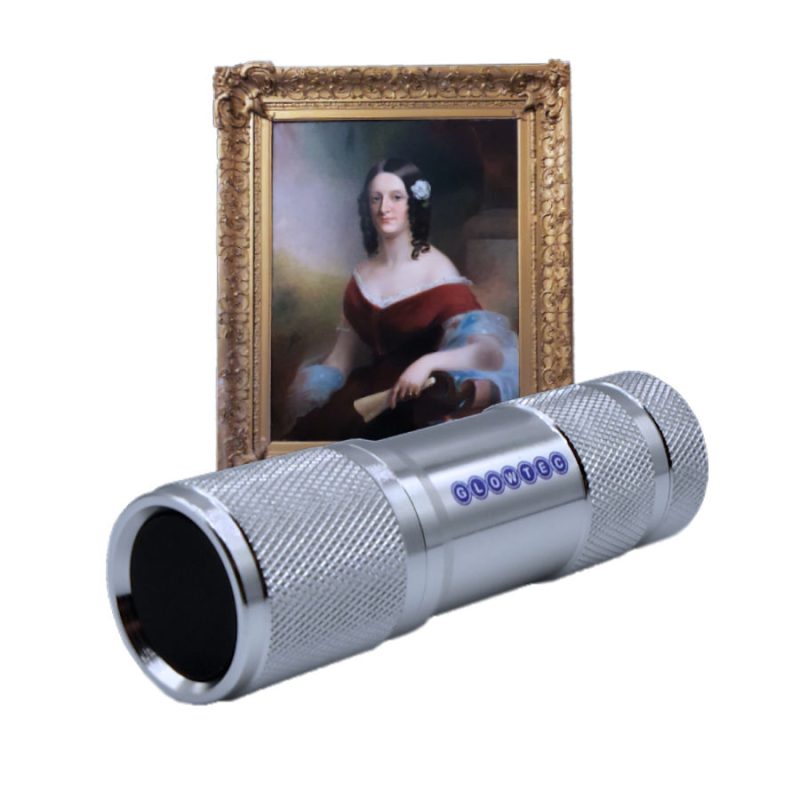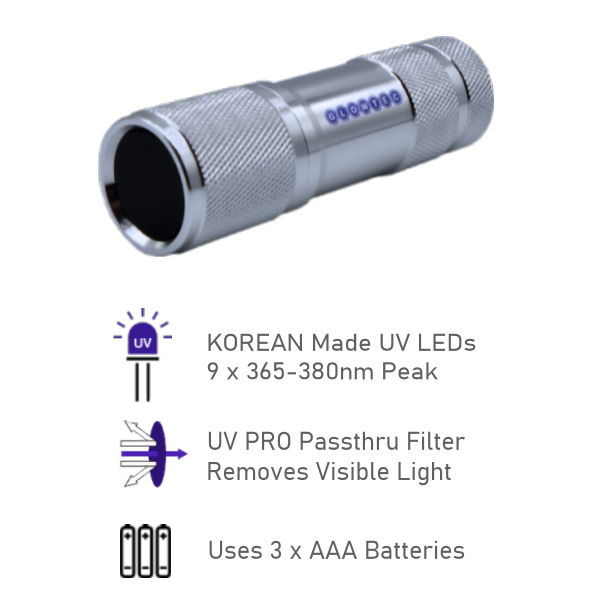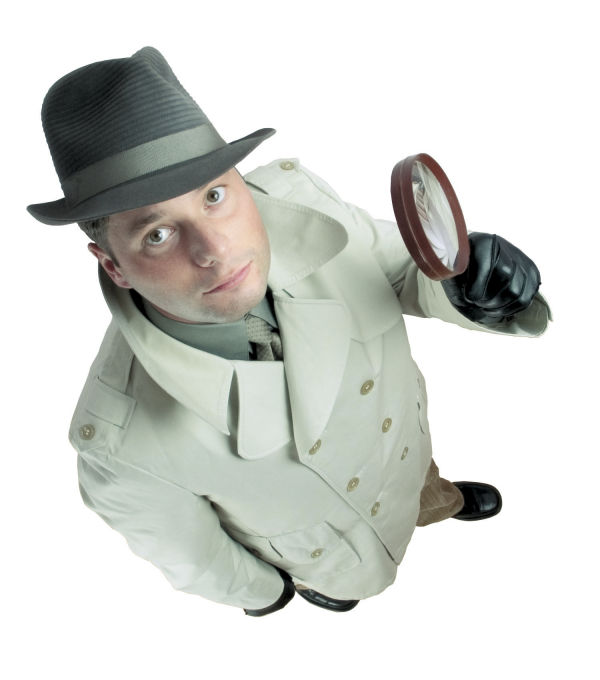UV Antique Detector Pro
Reveals Hidden Touch-ups, Repairs & Fakes

Antiquing is more popular now than it has ever been. However, for the untrained eye, it is a market awash with pieces which have been badly repaired, composite or simply fakes!
Antique Traders and Professionals already know the importance of UV light in helping them determine the ‘true’ condition or authenticity of a given item.
It can tell them if it has previously been repaired (and if so how well). If the item is genuinely old or of later manufacture pro-porting to be Antique, a marriage of parts (composite) or an out and out fake.
Use on most Antique materials
- Paper & Parchement
- Antique Paintings
- Antique Wood
- Antique Metal
- Antique Glassware
- Antique Porcelain
- Antique Jewellery
- Antique Tapestry
- Precious Gemstones
One of the key reasons why the UV Antique Detector Pro is so good at what it does, is the superior quality Korean made UV LEDs we use, together with our unique UV PRO Filter which removes 99% of visible interference light, so you only see the glow from the substance or surface material to the invisible UV light emitted.

How do you UV check Antiques?

While UV light can be a useful tool in examining certain aspects of antiques, it is not typically the only method for determining value or authenticity. However, here are a few considerations when using UV light to assess an antique:
General UV Inspection of Antiques
Restoration and repairs: UV light can reveal areas that have been restored, repaired, or touched up. Repaired sections may fluoresce differently than the original parts of the antique. Look for inconsistencies in fluorescence, such as brighter or darker areas, which could indicate repairs.
Modern materials: UV light can help identify the presence of modern materials, such as paints, dyes, varnishes, or adhesives. These materials may fluoresce differently than the authentic materials used during the antique’s era. Look for areas with unnatural or inconsistent fluorescence.
Anomalous markings: Some antiques may have markings or signatures that are difficult to discern with the naked eye. UV light can sometimes make these markings more visible, allowing you to verify their authenticity. Pay attention to any markings that fluoresce abnormally or appear to have been added later.
Age-related features: Antique materials can exhibit natural signs of aging, such as patina, discoloration, or oxidation. UV light may highlight these age-related features, helping to authenticate the antique’s age and originality.
Consult experts: While UV light examination can provide insights, it’s crucial to consult with experts in the specific type of antique you are evaluating. They can offer their knowledge, experience, and additional authentication methods to verify the genuineness of the antique.
Whilst UV light can quickly reveal ‘patination anomolies’, hidden repairs, touch-ups and alterations, it is just one part of the authentication process. It should be combined with other methods, including historical research, examination of construction techniques, materials analysis, comparison with known authentic examples, and expert consultation, to ensure a more accurate determination of authenticity.
Antique Repair Inspection…
Patchy fluorescence: If there are areas of the furniture that fluoresce differently or patchily than the surrounding areas, this could be a sign of repairs or touch-ups. The patched areas may be brighter or darker than the surrounding wood.
Different colours: If the furniture has been repaired with a different type of wood or filler, it may fluoresce differently under UV light. Look for areas where the fluorescence appears to be a different color than the surrounding wood.
Unnatural-looking fluorescence: If the furniture has been over-polished or refinished, it may have an unnatural look under UV light. Look for areas where the fluorescence appears to be too bright or uniform.
Cracks or seams: If the furniture has been repaired with glue or other materials, these areas may fluoresce differently than the surrounding wood. Look for cracks or seams that appear brighter under UV light.
Metal parts: If the furniture has metal parts, such as hinges or locks, check these for signs of repair or welding. Welded areas may not fluoresce like the rest of the metal.
Antique Artwork Inspection…
Restoration or repair: If the painting has been restored or repaired, the repaired areas may fluoresce differently than the surrounding areas. Look for areas that appear brighter or darker than the rest of the painting.
Modern additions: If the painting has been embellished with modern paint, these areas may fluoresce differently than the original painting. Look for areas that appear brighter or a different color than the rest of the painting.
Over-painting: is when an artist paints over an existing image. This can be detected under UV light, as the original image may fluoresce differently than the overpainted areas.
Retouching: is when an artist touches up certain areas of a painting. This can be detected under UV light, as the retouched areas may fluoresce differently than the surrounding areas.
Signature verification: Signatures on paintings can also be verified under UV light. If the signature fluoresces differently than the surrounding paint, this could be a sign that the signature was added later.
Important Note
Not all antique items or repairs will fluoresce under UV light and fluorescence alone is not a guarantee of authenticity.
UV light can, however, be a useful tool in detecting repairs or alterations to antique furniture, but it should be used in conjunction with other methods, such as examining the construction and style of the piece, researching the maker and provenance, and consulting with experts.
Do not allow children to use this product unsupervised.
Remember. Safety first! Do not shine torch beam directly into the eyes or at faces.
UV Blacklight in a Nutshell
There is so much mis-information online about UV light (Blacklight) we’ll clear up a few main points here…

No. Absolutely not. UV is invisible to the human eye so ideally you should see nothing! What you do see is visible ‘interference’ light (known as spill) which is a bi-product of poor quality inferior UV LEDs. This bright, purple glare is not UV and only serves to illuminate the search area, actually making it harder to see the fluoresce you are looking for!
The rule of thumb is: The brighter it is, the worse it is!
This is why our UV PRO Forensic Torch (a.k.a Stain Detective Pro) is fitted with a special UV PRO filter which removes 99% of unwanted visible light and only lets the invisible UV light through. This produces stunning, professional results across the board.
Again. Absolutely not. The greater the number of inferior (cheap) LEDs the torch has, the more visible interference light it produces and the worse the end result.
Tip: Avoid any UV Torch with more than 9 LEDS.
Yes. The frequency of UV light emitted determines the quality of results obtained. There is a sweet-spot for UV which is between 365nm and 385nm. However, to manufacture LEDs capable of emitting in this frequency range is far more expensive.
The cheap UV torches sold on eBay and Amazon, will use inferior-quality Chinese made LEDs emitting in the range of 390 – 410nm. At this range the UV light is a very poor quality and the visible light output is at its highest!
(see here for more about UV Blacklight).
GLOWTEC UV PRO Forensic Torches are made using high quality KOREAN made UV LEDs which peak at 380nm and a low visible light output. This provides the best balance of quality, performance and price, and offers so excellent value for money.
See our short comparison video –> https://hand-hygiene.com/videos/
That really depends on what it is your are looking at / looking for!
Unlike man-made fluorescent materials such as white fabric, white paper and UV paint which fluoresce brightly under UV blacklight, natural fluorescent substances, such as urine and body fluids etc, whilst they do glow (fluoresce) under UV, they do NOT fluoresce brightly. In fact they are generally quite dim, so do not expect a supernova! You will be looking for areas slightly brighter than their background; you’ll know them when you see them.
There are many factors which determine how bright a stain will be (or not be). In fact too many to mention all of them. In short; old stains are generally dimmer than recent ones. Different types of stains can glow in different colours and varying degrees of intensity.
Despite the common misconception. Human blood does NOT glow / fluoresce under UV light. In fact it does the opposite; it absorbs UV light. It would therefore have a very dark appearance under UV light.
See ‘Delivery’ for our dispatch days, shipping costs and options. Prices exclude VAT.
